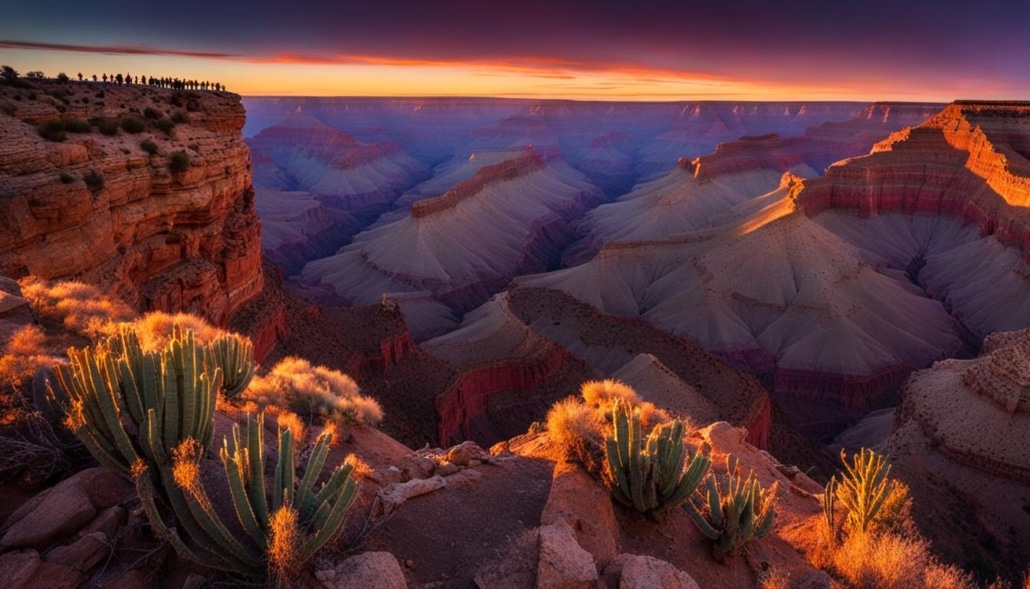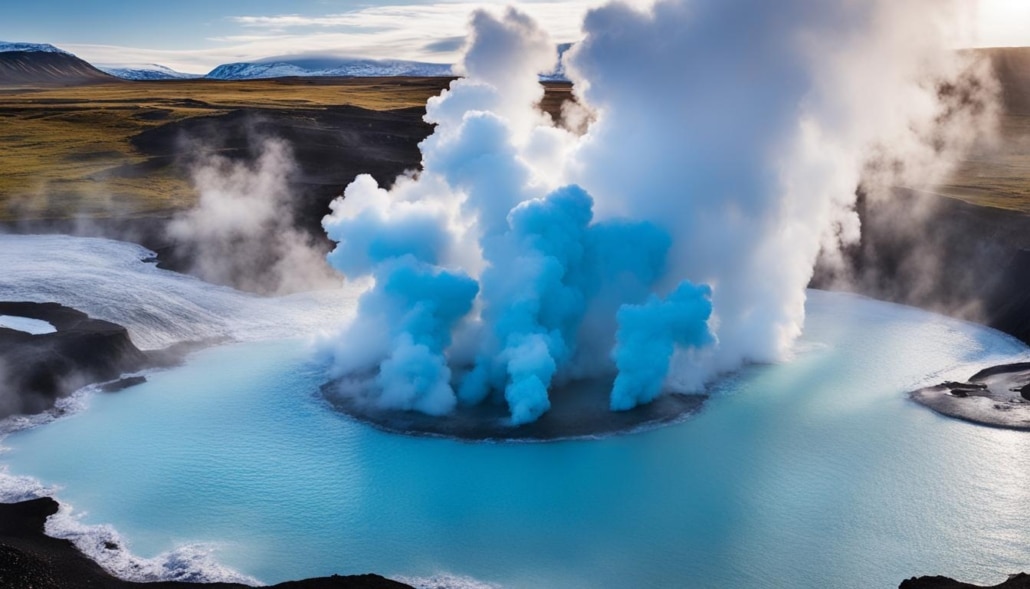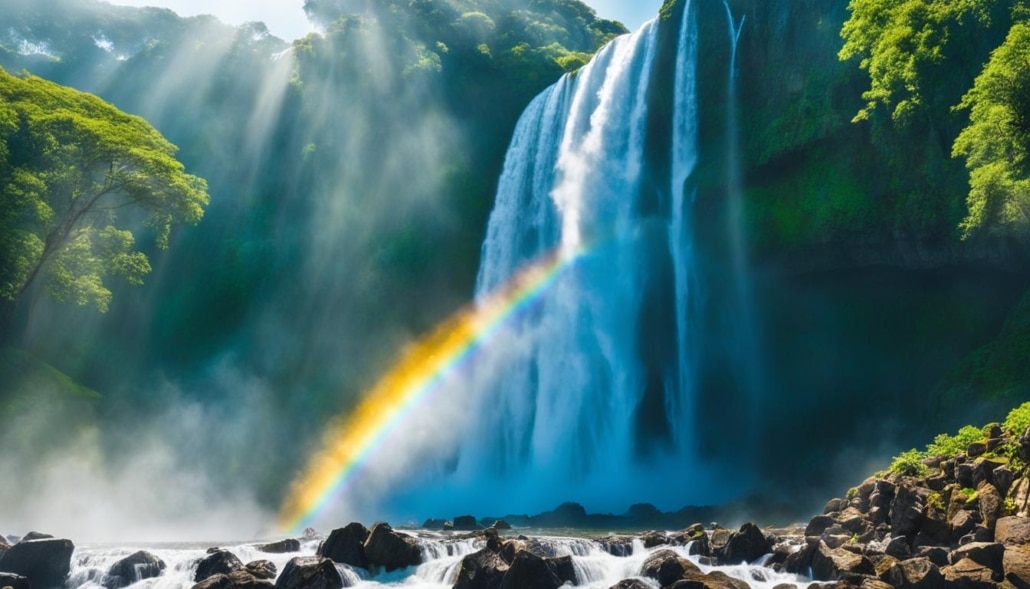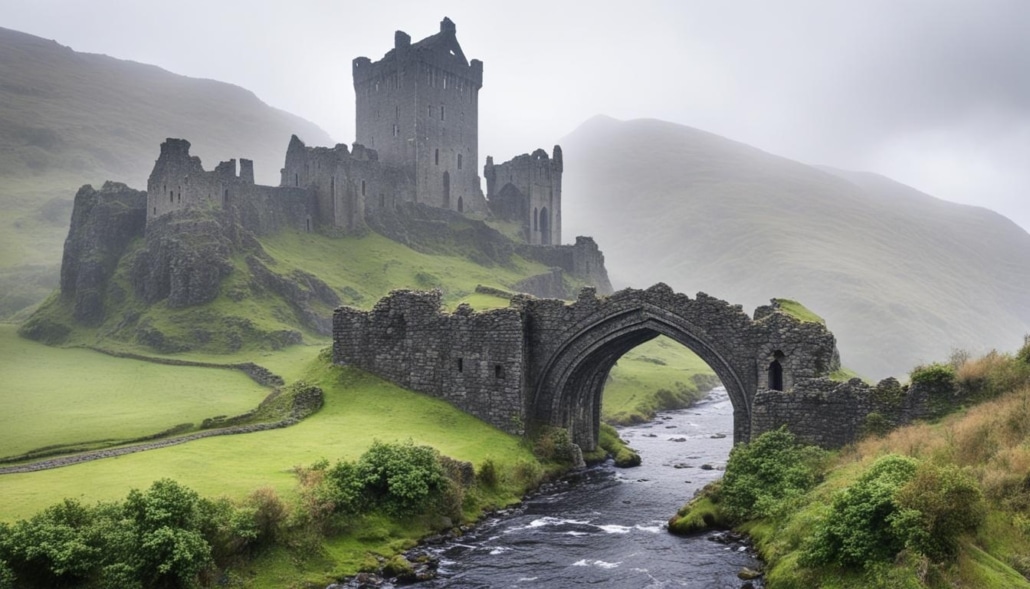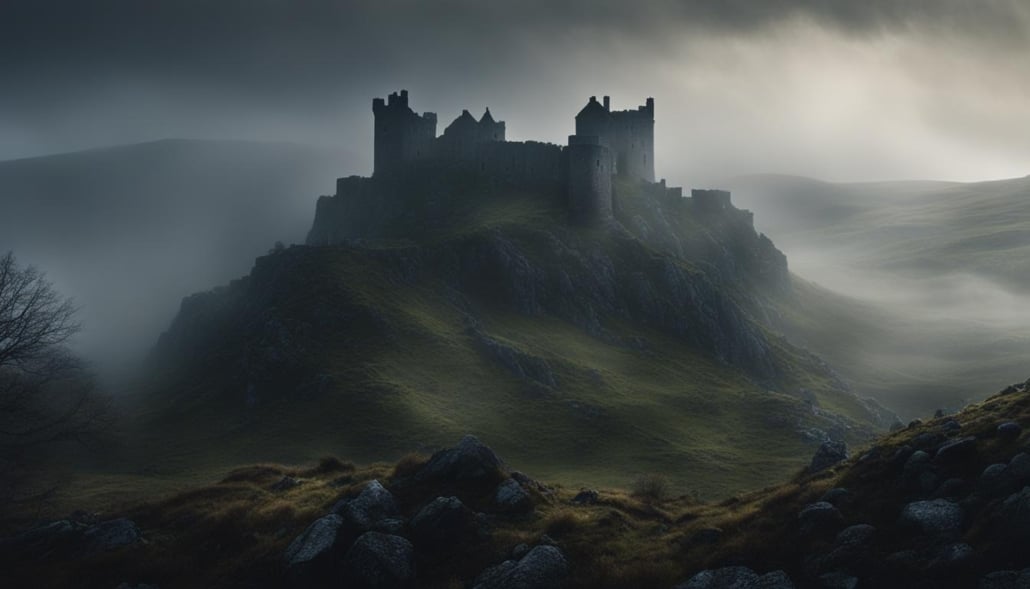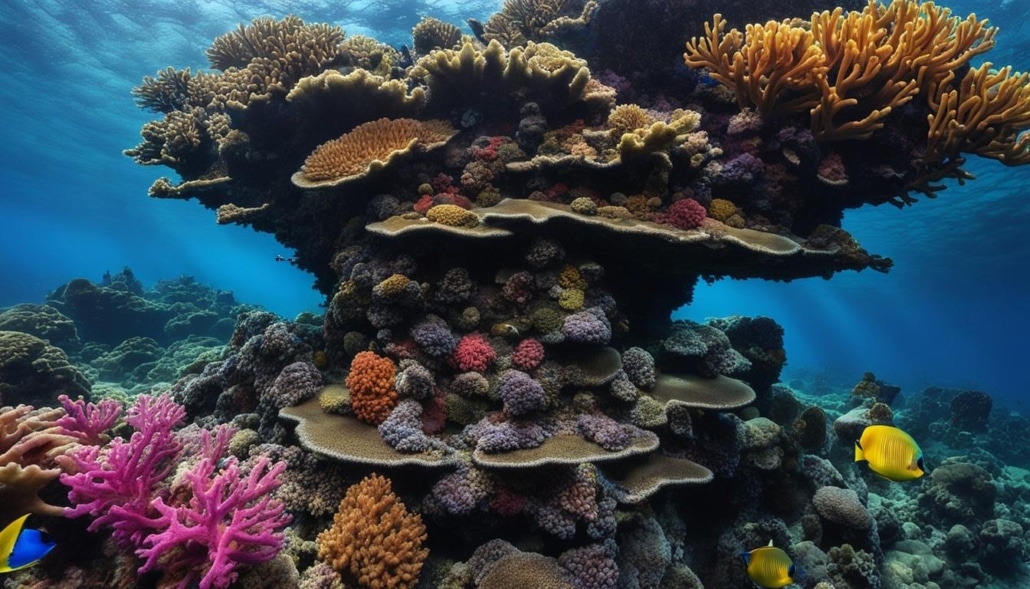The Grand Canyon is a must-visit destination for hikers, offering breathtaking views and the opportunity to explore one of the world’s great natural wonders. With its 18-mile length and over 6,000 feet of depth, the Grand Canyon showcases 2 billion years of geology along the Colorado River. Hiking into the canyon allows hikers to get up close and personal with the colorful geologic layers and witness some of the most complete geologic columns in the world.
When you step foot into the Grand Canyon, you are mesmerized by the vastness and grandeur of its natural beauty. Carved over millions of years, the canyon’s walls reveal a stunning tapestry of layered rocks, where each color tells a story of the Earth’s history. It is a place that evokes awe and wonder, drawing in hikers from all over the world to experience its magnificence firsthand.
Whether you’re an experienced hiker seeking a thrilling adventure or a nature enthusiast looking for a serene escape, hiking the Grand Canyon offers an unparalleled experience. As you traverse its trails, you’ll be rewarded with panoramic views of deep canyons, towering cliffs, and the mesmerizing play of light and shadow on the rugged landscape. The sheer beauty and immensity of the Grand Canyon will leave you breathless.
Join us as we delve into the world of Grand Canyon hiking and discover the best trails, tips for planning your adventure, what to expect in terms of weather and conditions, and the various options for guided and self-guided hikes. Whether you’re a seasoned hiker or a novice explorer, we’ll provide you with all the information you need to make your Grand Canyon hiking experience truly unforgettable.
The Best Views Are Below the Rim
One of the secrets to experiencing the Grand Canyon’s best views is to hike below the rim. While the top offers impressive vistas, the true scope of the canyon’s size and beauty can only be fully appreciated by hiking down into its depths. The expansive views of the colorful rock sequences and the diverse flora and fauna make the hike into the canyon an unforgettable experience.
As you descend below the rim, you’ll be greeted by panoramic views that stretch as far as the eye can see. The layers of sedimentary rock in various hues, ranging from reds and browns to purples and grays, create a breathtaking tapestry that reveals millions of years of geological history. These vibrant colors, combined with the dramatic cliffs and deep canyons, make every step below the rim a feast for the eyes.
“The Grand Canyon below the rim is like stepping into another world. The scale and beauty are simply awe-inspiring.”
The hike below the rim also offers the opportunity to immerse yourself in the diverse ecosystems of the Grand Canyon. As you descend, you’ll encounter different vegetation zones, from piñon-juniper woodlands to ponderosa pine forests. Keep an eye out for wildlife such as mule deer, squirrels, and a variety of bird species. The canyon is home to over 90 mammal species, 355 bird species, and over 900 plant species.
The experience of hiking below the rim is not just about the breathtaking views and vibrant landscapes. It’s also about connecting with the rich history and natural wonders that the Grand Canyon holds. As you explore the narrow trails and descend into the canyon’s depths, you’ll feel a sense of wonder and appreciation for the forces that shaped this magnificent geological masterpiece over millions of years.
Unforgettable Views Below the Rim
Here are some of the best viewpoints below the rim in the Grand Canyon:
- Plateau Point: Located along the Bright Angel Trail, the expansive views from Plateau Point offer a stunning panorama of the inner canyon.
- Indian Garden: A peaceful oasis nestled within the canyon, Indian Garden provides a serene setting to rest and enjoy the surrounding beauty.
- Roaring Springs: Accessible via the North Kaibab Trail, Roaring Springs rewards hikers with beautiful cascades and a refreshing atmosphere deep in the canyon.
Exploring these viewpoints will give you a taste of the breathtaking beauty that awaits as you venture below the rim of the Grand Canyon.
| Trails | Distance | Elevation Change |
|---|---|---|
| Bright Angel Trail | 9.8 miles (one way) | 4,380 feet |
| South Kaibab Trail | 6.8 miles (one way) | 4,780 feet |
| North Kaibab Trail | 14.4 miles (one way) | 5,770 feet |
Planning Your Hike in the Grand Canyon
When it comes to exploring the Grand Canyon, planning ahead is key to ensure a successful and enjoyable hiking experience. With options to access the canyon from the North Rim and the South Rim, hikers can choose their preferred starting point based on their preferences and trail options.
North Rim
The North Rim of the Grand Canyon sits at a higher elevation of about 8,000 feet, offering a unique and less crowded experience. The North Rim provides access to different ecosystems and stunning views of the canyon. Hiking trails in this area showcase the diverse flora and fauna of the Kaibab Plateau, providing hikers with a truly immersive experience in nature.
South Rim
The South Rim of the Grand Canyon is open year-round and is a popular destination for hikers. This rim offers a variety of relatively flat trails along the rims themselves, perfect for taking in the breathtaking panoramic views of the canyon. For those seeking a more adventurous hike, the South Rim also provides steeper trails that descend into the canyon, allowing hikers to explore the depths of this natural wonder.
When planning your hike, consider the trail options available on each rim. Research the difficulty levels, distances, and estimated hiking times to ensure you choose a trail that matches your skill and fitness levels.
Additionally, it’s important to take into account the weather conditions at the time of your visit. The Grand Canyon experiences extremes in temperature, with scorching heat in the summer and potentially freezing conditions in the winter. Check the weather forecast and be prepared with appropriate clothing and gear to stay comfortable and safe during your hike.
Lastly, availability of accommodations should be considered when planning your hike. Both the North Rim and the South Rim offer lodging options within the park, but reservations may be necessary, especially during peak seasons. It’s advisable to book your accommodations in advance to secure the best options for your stay.
By carefully planning your Grand Canyon hike, considering the trail options, weather conditions, and availability of accommodations, you can ensure a memorable and rewarding adventure in one of the world’s most awe-inspiring natural wonders.
Be Prepared for Varying Conditions
Hiking in the Grand Canyon offers breathtaking views and a chance to explore one of the world’s great natural wonders. However, it’s crucial to be prepared for the varying temperatures and conditions that you may encounter along the way.
The Grand Canyon boasts a significant temperature variation between the rim and the bottom of the canyon. While the rim may have mild temperatures, reaching above 100 ºF in the summer, the bottom of the canyon can be significantly warmer. It is essential to take this temperature variation into account and prepare accordingly.
To ensure a safe and enjoyable hiking experience, here are some essential tips to consider:
- Stay Hydrated: Carry ample amounts of water and electrolytes to stay hydrated during your hike. Dehydration can be a serious concern, especially in the heat of the canyon. It is recommended to bring at least one gallon of water per person per day.
- Start Early: Begin your hike early in the morning to avoid the peak heat of the day. This will help minimize the risk of heat exhaustion or heatstroke.
- Protect Yourself from the Sun: The sun can be intense in the Grand Canyon. Protect yourself by wearing sunglasses, a hat, and sunscreen with a high SPF. Sunburns and sunstroke can quickly ruin your hiking experience.
- Be Prepared for Snow and Ice: In the winter months, snow and ice can be present in certain areas of the canyon. It’s important to check with park rangers for trail conditions and carry appropriate gear, such as traction devices, if necessary.
Remember, safety should always be a priority when hiking in the Grand Canyon. Pay attention to weather forecasts and advisories and come prepared for any changes in conditions.
Quote:
“The Grand Canyon is an awe-inspiring natural wonder that offers unparalleled hiking opportunities. However, it’s important to respect the varying conditions and prepare accordingly to ensure a safe and enjoyable experience.” – Emily Johnson, experienced hiker
Grand Canyon Temperature Comparison (Rim vs. Bottom)
| Season | Rim Temperature (ºF) | Bottom Temperature (ºF) |
|---|---|---|
| Spring | 50-70 | 70-100+ |
| Summer | 70-90 | Above 100+ |
| Fall | 50-70 | 70-100+ |
| Winter | 20-40 | 30-50 |
Note: Temperatures are approximate and can vary based on weather conditions and elevation.
Choosing Between Guided and Self-Guided Hikes
When hiking in the Grand Canyon, you have the option to choose between guided or self-guided hikes. Guided hikes can provide a wealth of knowledge about the canyon, customized itineraries, and a hassle-free experience. However, if you prefer more flexibility and independence, you can opt for a self-guided hike. It’s important to plan ahead and consider your group’s skill level, objectives, and the potential for crowds and heat.
There are advantages and considerations for both guided and self-guided hikes in the Grand Canyon. Let’s explore the pros and cons of each option:
| Guided Hikes | Self-Guided Hikes |
|---|---|
|
|
|
Guided hikes in the Grand Canyon are recommended for first-time visitors or those who may require extra support in terms of navigation or safety. These hikes offer a structured and educational experience, allowing you to learn about the canyon’s geology, flora, and fauna from expert guides. Additionally, guided hikes often provide transportation, accommodations, and meals, making the entire experience hassle-free. |
Self-guided hikes are ideal for experienced hikers who enjoy planning their own routes and exploring at their own pace. This option allows you to fully immerse yourself in the natural beauty of the Grand Canyon, connecting with the wilderness on a more personal level. However, self-guided hikes require careful preparation, including acquiring permits, studying trail maps, and understanding equipment and safety requirements. It is crucial to be aware of your fitness level and choose trails that match your capabilities. |
Regardless of which option you choose, it’s important to prioritize safety and respect the natural environment. Stay hydrated, bring adequate supplies, and adhere to park regulations for a memorable and enjoyable hiking experience in the Grand Canyon. Now, let’s explore the fitness requirements for hiking in the Grand Canyon.
Fitness Requirements for Hiking in the Grand Canyon
Hiking in the Grand Canyon offers an incredible adventure, but it’s essential to assess your fitness level and trail difficulty before embarking on your journey. The trails in the Grand Canyon vary in length, elevation gain, terrain, and overall difficulty. It’s important to choose a trail that matches your skill and fitness levels to ensure an enjoyable and safe hiking experience.
Some trails, like the Trail of Time, provide a leisurely hike on relatively flat terrain with minimal elevation gain. These trails are suitable for hikers of all fitness levels, including beginners or those who prefer a more relaxed hiking experience. The Trail of Time is a scenic path that highlights the geologic history of the Grand Canyon, allowing hikers to immerse themselves in the captivating beauty of this natural wonder.
Other trails, such as the North Kaibab Trail to Roaring Springs, present more challenging and demanding conditions. These trails involve steep ascents, rough terrain, and steep drop-offs. Hiking on these trails requires a higher level of fitness, experience, and preparedness. It’s important to be physically and mentally prepared for the strenuous demands of these trails, as well as the potential hazards that may arise along the way.
“Choose a trail that matches your skill and fitness levels to ensure an enjoyable and safe hiking experience.”
Before embarking on any hiking adventure in the Grand Canyon, it is crucial to research trail maps and gather information about the trail’s difficulty, duration, and potential hazards. Visitor centers or park rangers can provide valuable insights and recommendations based on your fitness level and experience. It’s also recommended to start with shorter, less challenging hikes to assess your fitness level and gradually progress to more demanding trails as your skills and confidence improve.
By carefully selecting a trail that aligns with your fitness level and considering the trail difficulty, you can embark on a memorable hiking experience in the Grand Canyon that matches your abilities and goals.
| Trail | Difficulty Level | Elevation Gain | Terrain |
|---|---|---|---|
| Trail of Time | Easy | Negligible | Flat terrain |
| North Kaibab Trail to Roaring Springs | Difficult | 3,440 feet | Steep ascents, rugged terrain |
| South Kaibab Trail | Moderate | 4,780 feet | Steep drop-offs, exposed sections |
| Bright Angel Trail | Moderate | 4,380 feet | Slopes, switchbacks |
Best Times to Visit the Grand Canyon
The Grand Canyon offers different experiences throughout the year, each season with its own appeal for Grand Canyon hiking enthusiasts. Consider the following seasonal considerations when planning your visit:
Spring: Mild Temperatures and Fewer Crowds
Spring is an optimal time to visit the Grand Canyon for hikers. With mild temperatures and fewer crowds compared to the peak summer season, you can enjoy the natural beauty of the canyon in a more serene environment. Springtime also brings vibrant wildflowers blooming throughout the park, adding a burst of colors to your hiking adventures.
Summer: Long Days and Excellent Sightseeing
Summer offers long daylight hours, allowing hikers to explore the Grand Canyon to their heart’s content. This season provides plenty of daylight for sightseeing, capturing breathtaking photographs, and immersing yourself in the awe-inspiring beauty of the canyon. Be prepared for warmer temperatures and increased visitor traffic during the summer months.
Fall: Beautiful Foliage and Pleasant Weather
In the fall, the Grand Canyon comes alive with stunning foliage, as the leaves of deciduous trees change color, painting the landscape with shades of red, yellow, and orange. With pleasant weather and fewer crowds compared to the summer season, fall is a fantastic time for hiking in the Grand Canyon. Experience the canyon’s beauty in a peaceful and picturesque setting.
Winter: Quieter Experience with Some Closures
Winter offers a quieter and less crowded experience in the Grand Canyon. While some areas of the park may be closed due to snow or ice, you can still explore the rim trails and enjoy the tranquil atmosphere. Winter hiking in the canyon provides a unique perspective, as the snow-capped peaks and frost create a picturesque winter wonderland.
Depending on your preferences and tolerance for crowds, each season has its own charm and allure for hiking in the Grand Canyon. Now that you have an understanding of the best times to visit, plan your trip accordingly to make the most of your Grand Canyon hiking adventure.
Conclusion
Hiking in the Grand Canyon is an unforgettable experience that allows you to witness the awe-inspiring beauty of one of the world’s great natural wonders. From the moment you set foot on the trails, you’ll be immersed in a world of breathtaking landscapes and geological wonders that span billions of years.
With its diverse trails, the Grand Canyon caters to hikers of all skill levels. Whether you’re a seasoned trekker looking for a challenging adventure or a beginner seeking a more leisurely hike, there are trails that will suit your preferences. From the iconic South Rim to the secluded North Rim, the Grand Canyon offers stunning views at every turn.
Whether you choose to embark on a guided hike led by experienced guides or go on a self-guided adventure, it’s important to be prepared for the changing conditions of the Grand Canyon. The temperature variations, potential snow and ice in winter, and intense desert sun in summer all require careful planning and appropriate gear. But with proper preparation, you can fully immerse yourself in the grandeur of this natural wonder and create memories that will last a lifetime.
So, if you’re ready for an unforgettable experience, start planning your Grand Canyon hiking adventure today. Lace up your boots, pack your essentials, and get ready to explore the wonders of the Grand Canyon. Whether you’re captivated by the stunning views from the rim or venture below into the depths of the canyon, hiking in the Grand Canyon promises to be an experience that will stay with you forever.
FAQ
What makes hiking below the rim the best way to experience the Grand Canyon?
Hiking below the rim allows you to truly appreciate the size and beauty of the canyon, with up-close views of the colorful geology and diverse flora and fauna.
How can I access the Grand Canyon for hiking?
The Grand Canyon can be accessed from both the North Rim and the South Rim, each offering unique ecosystems and stunning views. The South Rim has trails on the rims and into the canyon, while the North Rim offers different ecosystems and higher elevation.
What should I consider when planning my hike in the Grand Canyon?
It’s important to plan ahead and consider trail options, weather conditions, and availability of accommodations when planning your Grand Canyon hike.
What should I be prepared for when hiking in the Grand Canyon?
Hiking in the Grand Canyon requires preparation for varying temperatures and conditions. Be prepared for significantly warmer temperatures in the canyon, carry ample water and electrolytes, start hiking early in the morning, and protect yourself from the sun.
Should I choose a guided or self-guided hike in the Grand Canyon?
The choice between guided and self-guided hikes depends on your preferences and needs. Guided hikes offer knowledge and a hassle-free experience, while self-guided hikes provide more flexibility and independence.
What fitness level is required for hiking in the Grand Canyon?
The fitness level required for hiking in the Grand Canyon depends on the chosen trail. There are trails suitable for all fitness levels, but some involve significant altitude gain, challenging terrain, and high-risk scrambling.
When is the best time to visit the Grand Canyon for hiking?
The Grand Canyon offers different experiences throughout the year. Spring has mild temperatures and fewer crowds, summer provides long days and great sightseeing opportunities, fall showcases beautiful foliage and pleasant weather, and winter offers a quieter experience.
What can I expect from hiking in the Grand Canyon?
Hiking in the Grand Canyon is an unforgettable experience that allows you to witness the awe-inspiring beauty of one of the world’s great natural wonders. With diverse trails, stunning views, and rich geology, the Grand Canyon offers something for every hiker.


